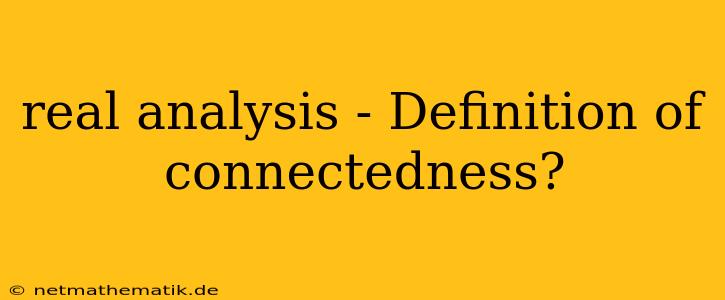In the realm of mathematics, particularly within the branch of real analysis, the concept of connectedness plays a fundamental role in understanding the structure and properties of sets. Connectedness, in essence, captures the notion of a set being "all in one piece," devoid of any gaps or breaks. While seemingly intuitive, its formal definition and implications are profound, impacting various areas of analysis, topology, and beyond. This article delves into the definition of connectedness, exploring its different forms and highlighting its significance in the mathematical landscape.
Definition of Connectedness in Real Analysis
At its core, connectedness in real analysis deals with the inability to separate a set into two disjoint, non-empty open sets. More formally, a subset $S$ of a topological space $X$ is considered connected if and only if there exist no two non-empty, open sets $U$ and $V$ in $X$ such that:
- $S \subseteq U \cup V$ (i.e., $S$ is covered by the union of $U$ and $V$)
- $U \cap V \cap S = \emptyset$ (i.e., the intersection of $U$, $V$, and $S$ is empty)
Essentially, this definition stipulates that if we try to "split" a connected set $S$ into two open subsets, these subsets will invariably share at least one point that belongs to $S$.
Understanding the Definition
To grasp this concept, consider the familiar example of the real number line $\mathbb{R}$. The interval $[0, 1]$ is connected because no matter how we try to divide it into two open sets, the intersection of those sets will always contain a point from the interval. For instance, if we take $U = (-\infty, 0.5)$ and $V = (0.5, \infty)$, we see that their intersection is empty, and therefore, they cannot be used to separate $[0,1]$.
However, the set $S = [0,1] \cup [2,3]$ is not connected. We can easily find open sets $U = (-1, 1.5)$ and $V = (1.5, 4)$ that cover $S$ but have an empty intersection with $S$. This demonstrates that $S$ can be "split" into two separate components, rendering it disconnected.
Types of Connectedness
The concept of connectedness extends beyond the basic definition. There are several types of connectedness, each emphasizing a particular aspect of the "non-separable" property:
Path Connectedness
A set $S$ is path-connected if for any two points $x$ and $y$ in $S$, there exists a continuous function $f: [0,1] \rightarrow S$ such that $f(0) = x$ and $f(1) = y$. This means that we can connect any two points in $S$ via a continuous path that lies entirely within $S$.
Path-connectedness implies connectedness, but the converse is not always true. For example, the graph of the function $y = \sin(1/x)$ for $x \neq 0$ is connected but not path-connected. While the graph is "all in one piece," we cannot connect any two points on the graph with a continuous path.
Locally Connected Sets
A set $S$ is locally connected if every point $x$ in $S$ has a neighborhood that is connected. In simpler terms, if we zoom in on any point in $S$, the magnified region will still be a single, "unbroken" piece.
Local connectedness does not imply connectedness, nor is it implied by connectedness. For example, the set of rational numbers $\mathbb{Q}$ is locally connected but not connected. However, a set like $\mathbb{R} \setminus {0}$ (the real numbers excluding zero) is connected but not locally connected at the point $x = 0$.
Significance of Connectedness
The notion of connectedness has profound implications in various areas of mathematics:
1. Real Analysis: Connectedness plays a vital role in the study of continuous functions. For instance, the intermediate value theorem states that a continuous function defined on a connected set must take on all values between its minimum and maximum. This theorem relies heavily on the concept of connectedness to ensure that the function doesn't "jump" over any values.
2. Topology: In topology, connectedness is a fundamental property used to classify and study topological spaces. Connectedness is a topological invariant, meaning that it remains preserved under homeomorphisms. This property makes it a valuable tool for distinguishing between different topological spaces.
3. Complex Analysis: The concept of connectedness is crucial in complex analysis, where it forms the basis for understanding the properties of analytic functions and their domains. Connectedness ensures that analytic functions exhibit certain desirable behaviors, such as having unique values within their domains.
4. Differential Equations: Connectedness is relevant in the analysis of differential equations, where it helps to understand the behavior of solutions and their existence. Solutions to differential equations often reside within connected sets, making connectedness a key factor in determining their properties.
Conclusion
Connectedness, as a fundamental concept in real analysis, provides a powerful framework for understanding the structure and properties of sets. By capturing the notion of "being in one piece," connectedness plays a pivotal role in various mathematical disciplines. Its implications extend far beyond the realm of basic definitions, impacting the behavior of continuous functions, the classification of topological spaces, and the analysis of complex functions and differential equations. Therefore, understanding the different types and applications of connectedness is essential for navigating the rich tapestry of mathematical concepts.
